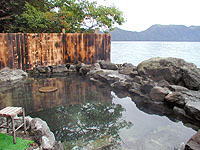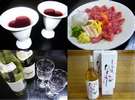|
 Japanese Japanese
 Since Japan is a country with many volcanoes, there are hot springs all
over the country from north to south. According to the Ministry of the
Environment, there are more than 3,000 hot spring resorts in Japan Since Japan is a country with many volcanoes, there are hot springs all
over the country from north to south. According to the Ministry of the
Environment, there are more than 3,000 hot spring resorts in Japan
In comparing Western and Japanese hot springs, we can see a major cultural
difference: Whereas in the West people have used hot springs for exercise and
thermotherapy, always wearing a swimsuit when doing so, in Japan people have used
them by soaking themselves up to their shoulders while naked.@These
natural treasures have been used by many not only for medical purposes but also
as places to interact with others and relax.
There is a Japanese expression, gHadaka no tsuikiai,h which basically
translates as ggetting to know each other while naked.h The idea is that when
you are naked itfs easier to open yourself up to other people as you forget
about hiding yourself or putting up any fronts of vanity. This concept may very
well have been created because of the fact that the Japanese are normally bound
by strict regime of superior-inferior relationships.
Because of such cultural
background and history, Onsen, since ancient times, have always been a central feature
of Japanese tourism. Popular onsen resorts are often crowded with couples,
families or company groups who want to get away from the hectic life of the
city to relax.
 Visiting onsen resorts is not only one of the most popular holiday activities among the
Japanese, but is also highly recommended for any foreign visitors of Japan.
The ultimate in hot springs can be experienced by spending a night at an
onsen ryokan, a Japanese
style inn with hot spring baths. Onsen
ryokan can be found in various sizes in hot spring resorts across Japan. A typical
onsen ryokan visit starts
with a bath before dinner. The beautifully arranged Japanese style dinner can
be enjoyed not only in a dining hall but also in your room. Eating in your own
room is called gHeya-shoku,h and is considered one of the luxuries at
Japanese-style inns. Many guests like to take another bath before sleeping and
before breakfast the next morning. Visiting onsen resorts is not only one of the most popular holiday activities among the
Japanese, but is also highly recommended for any foreign visitors of Japan.
The ultimate in hot springs can be experienced by spending a night at an
onsen ryokan, a Japanese
style inn with hot spring baths. Onsen
ryokan can be found in various sizes in hot spring resorts across Japan. A typical
onsen ryokan visit starts
with a bath before dinner. The beautifully arranged Japanese style dinner can
be enjoyed not only in a dining hall but also in your room. Eating in your own
room is called gHeya-shoku,h and is considered one of the luxuries at
Japanese-style inns. Many guests like to take another bath before sleeping and
before breakfast the next morning.
Some people from foreign countries may think, gI am uncomfortable going
to Japanese hot springs because I donft know what is proper or improper
there.h Here we will introduce a few basic points on how to take a bath
at Japanese hot springs
1) Take off all your clothes in the
changing room and place them into a basket together with your bath towel. Coin lockers
for valuables are often available.
2)
Japanese hot springs are to be enjoyed naked. Swimming suits are not allowed
in most places. However, it is custom to bring a small towel into the bathing
area, with which you can cover yourself while outside of the water. Once
you enter the bath, keep the towel out of the water.
3) Before entering the bath, put water
from either a faucet or the bath into a provided washbowl, and pour it onto
yourself to rinse yourself clean. Just rinsing your body like this is usually
sufficient unless you are excessively dirty, in which case you should use soap.
4)
Enter the bath and soak for a while.
Note that the bath water can be very hot (typical temperatures are 40 to 44
degrees Celsius). If it feels too hot, try to enter very slowly and move as
little as possible.
5) After soaking for a while, get out of
the bath and sit in front of one of the water taps to wash yourself off with
soap. Soap and shampoo are provided in some baths. Just as in the case of
private Japanese bathrooms, make sure that no soap gets into the bath water. After
cleaning your body, be sure to tidy up the space you used.
6)
Re-enter the bath and soak some
more.
7)
After you have finished soaking, do
not rinse your body with tap water, so that the minerals from the hot spring take
maximum effect on your body.
This may sound difficult, but all you need to know is to keep the bath
water clean so that everyone can enjoy it.
For those who feel
reluctant to bathe in the presence of others, we recommend choosing a guestroom
equipped with a bathing room. In recent years, there have been an increasing
number of ryokans with guestrooms
attached to private rotenburo
(open-air bath). When entering a rotenburo that has a nice view, you can
experience the sensation of being one with nature.
Taking
a quiet and leisurely soak by yourself is one option, or you can have lively
conversation in the bathtub with your friends or family. Lounging in a spacious bathtub will soothe
away your daily fatigue and stress for sure!
|

 Visiting onsen resorts is not only one of the most popular holiday activities among the
Japanese, but is also highly recommended for any foreign visitors of Japan.
The ultimate in hot springs can be experienced by spending a night at an
onsen
Visiting onsen resorts is not only one of the most popular holiday activities among the
Japanese, but is also highly recommended for any foreign visitors of Japan.
The ultimate in hot springs can be experienced by spending a night at an
onsen 